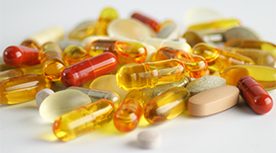LSDs Treatment
 Most of the LSDs, and in particular the MPSs mainly involve different levels of peripheral organ and the CNS. In all types, however, the CNS involvement is the major cause for morbidity and early mortality. This is particular true for MPSIII, which is characterized by the most severe CNS involvement. Many of the available treatments can result efficacious only if they are administered before neurodegeneration becomes irreversible. The BBB in fact, maintains the brain internal fluid environment extremely stable, and represents a protective barrier which shields the CNS from any neurotoxic substances which circulate in the blood but at the same time it severely limits the penetration of many drugs and therapeutic agents into the CNS. For this reason many of the therapeutic enzymes used in Enzyme Replacement Therapy (ERT) are not able to reach the CNS in adequate amounts and modify the course of neurodegeneration in the CNS.
Most of the LSDs, and in particular the MPSs mainly involve different levels of peripheral organ and the CNS. In all types, however, the CNS involvement is the major cause for morbidity and early mortality. This is particular true for MPSIII, which is characterized by the most severe CNS involvement. Many of the available treatments can result efficacious only if they are administered before neurodegeneration becomes irreversible. The BBB in fact, maintains the brain internal fluid environment extremely stable, and represents a protective barrier which shields the CNS from any neurotoxic substances which circulate in the blood but at the same time it severely limits the penetration of many drugs and therapeutic agents into the CNS. For this reason many of the therapeutic enzymes used in Enzyme Replacement Therapy (ERT) are not able to reach the CNS in adequate amounts and modify the course of neurodegeneration in the CNS.
ERT is not able to penetrate the Blood-Brain Barrier (BBB), due to its selectivity for proteins and the fact that the molecular weight of the recombinant enzymes exceeds the permeability of the BBB.
Therefore, one of the Brains for Brain major aim is to design, develop and validate efficient strategies to deliver effective therapy that reverses LSD neurodegeneration to the CNS by molecular and cellular tools as:
- Small molecules able to reach the CNS.
- Gene therapy based on the direct injection of adeno-associated viruses (AAV) vectors carrying the missing enzyme gene in the brain.
- ERT using modified enzymes that can traverse the BBB
- Nanotechnology
The understanding of the pathpopysiological process and the advancement of knowledge on biochemical and molecular basis of the diseases have a very important role on the development of innovative therapies which may modify the natural history of the disease and slow the neurodegeneration process.
Recommended reading material and reviews:
New strategies for the treatment of lysosomal storage diseases (review).
Parenti G, Pignata C, Vajro P, Salerno M.
Int J Mol Med. 2013 Jan;31(1):11-20. doi: 10.3892/ijmm.2012.1187. Epub 2012 Nov 19. Review.
